Smoking a Beef Brisket on a Gas Grill
Learn how easy it is to cook a brisket on your backyard gas grill with these easy to follow step by step photo instructions. You too can enjoy one of the Kings of BBQ at home.
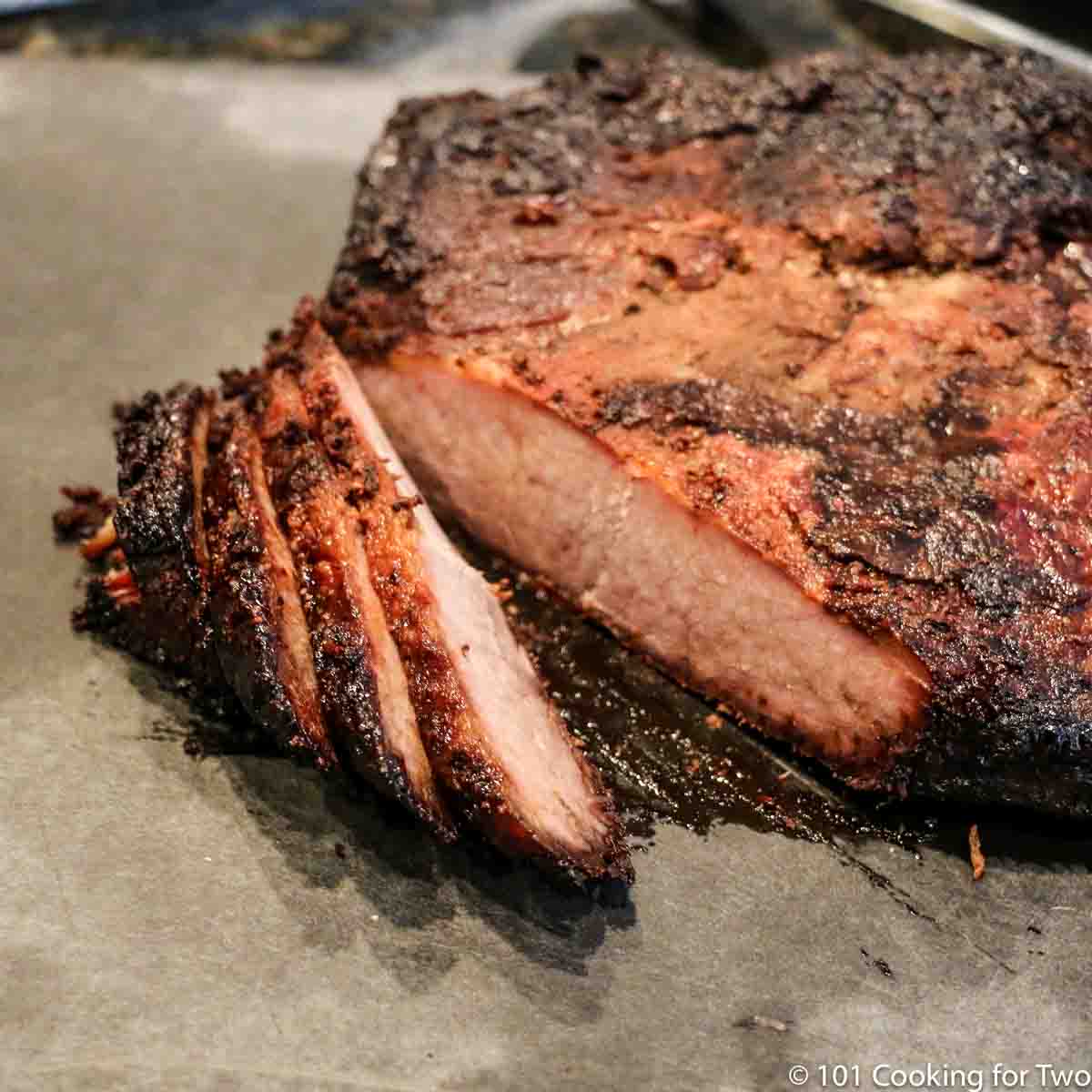
Introduction
I love brisket. It is almost my favorite meat. I usually cook brisket with Kansas City Oven Baked BBQ Beef Brisket and it is a family favorite. So I'm treading on dangerous ground here but time for something with a great bark that you don't get from the oven method.
First and most important, you need to set up your grill for indirect cooking and smoking. See my previous post How to Set To Up Your Gas Grill for Smoking and Low and Slow Cooking . This is the key to any cooking of this type.
I started with a basic rub, some sugar, paprika, salt, and pepper. You can complicate this as much as you want, but these are the basics of a rub. Now cooking it low and slow, add some smoke and you're there. Not a complicated thing.
My Rating

A very nice 5. Very good.
🐄Brisket
Beef brisket is a cut of meat from the lower chest wall. The brisket includes superficial and deep pectoral muscles. The cow does not have collar bones, so these muscles support about 60% of the bodyweight of an 1500 pound cow.
All that work produces a lot of connective tissue, so cooking a brisket is all about melting the connective tissue completely. Read that as low and slow. It is the melted collagen that gives you wonderful results.
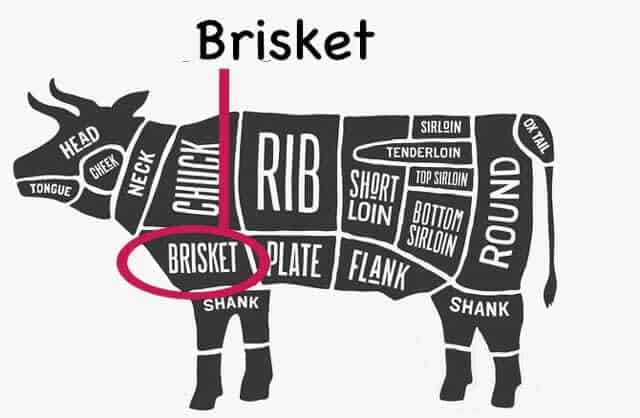
Whole briskets are generally vacuum packed for the producers and are usually 8 to 12 pounds which is more meat than most of us "cooking for two" people want except for parties. Think about ½ pound per person as a common serving.
I usually buy half briskets. There are the "point" and "flat" halves. Generally, the point half is two layers, and the flat with only one layer of muscle.
I tend to buy flats, so I don't need to deal with the two layers, but either is fine. Around me, most "point" cuts include a layer of the flat, so there are two layers usually, but the point is that upper layer. The point may be a bit more tender though.
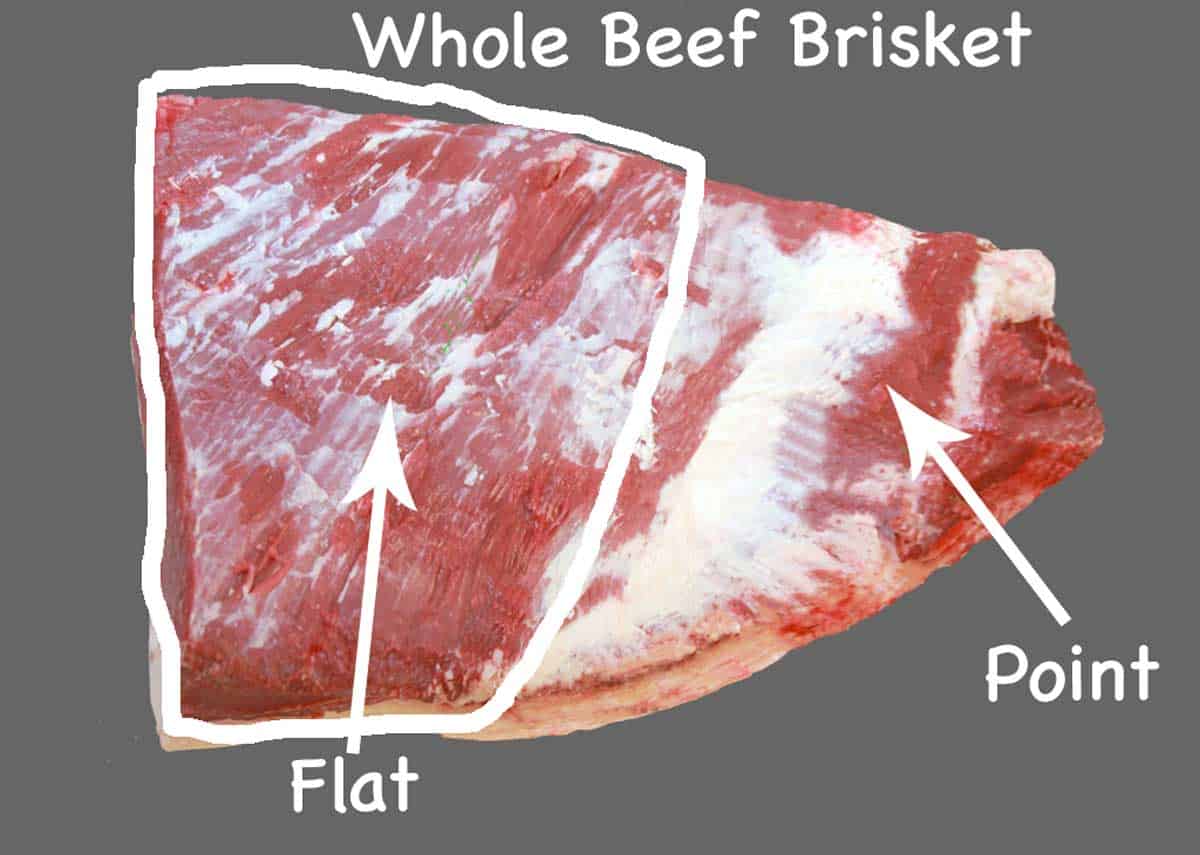
✔️Tips
Trimming the Fat. Yes or no?
The anti-trimming gang says it is natural and will protect the meat.
The trimmers will argue it makes a big mess and that it is the melting of collagen that produces most of the moisture. Also, more area for the rub to be on the meat. I'm not eating a chunk of fat just because it has the "bark" on it.
A compromise is to trim the fat to ¼ inch thick. This is usually what I do now but the picture is a full trim.
To Inject or Not to Inject?
I don't. You can add a variety of flavors, but I don't want to do that.
Is it moister? Some say yes, some say no. If yes then it is marginal.
Research it carefully before doing this. Mistakes can ruin your brisket.
Should You Brine?
Some people swear by it, but most competition smokers don't. I have never been a fan if brining beef. I have experimented with it with other cuts of beef and I felt it took away the "beef" flavor a bit.
🌡️Temperature
I usually do 250° but feel that is the highest you should go or you may have more drying. Most smokers will use 225°.
Some recipes will suggest all the way to 300° and talk about how wonderful it is. Yep, it is wonderful because it is brisket, but it would be moister, and "wonderful-er" if cooked lower.
Please see How to Set Up a Gas Grill for Smoking and A Beginners Guide to Grill Temperature on a Gas Grill for low and slow grill set up instructions if you need help.
You must have a good grill surface thermometer to do this correctly. Along with the required surface thermometer, a continuous read probe thermometer is a good idea.
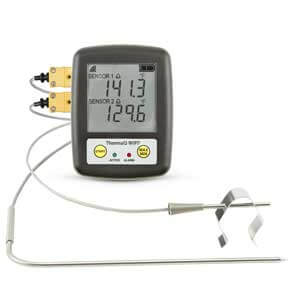
I used the Thermoworks Therma Q Blue (This is an affiliate link, meaning I do make a small amount from your purchases. Your price is not affected by this commission.)
⏰Time
Most will say 1 to 1 ½ hours per pound assuming a 250° grill. Not a bad starting point for time management but a wide range.
More important than weight is probably thickness. A plump 8-pound brisket may take as long or longer than a thinner 10-pound brisket.
There are lots of variables: grill temperature, thickness, weight, and if you do a Texas crunch wrap (see two sections down). There are probably more. So no two briskets will cook the same.
When is a Brisket Done?
I like 200°-205° but this is a personal test thing. I think 190 is too low. 195°-200° will slice nicely. 203° seems to be the number I see from competition smokers. 205°-210° is ok. But over 210° is probably too much and will become a texture and moisture issue.
The Stall
"The Stall" happens when the fibers of the meat contract when nearing the "well done" zone of 150° to 160°. This occurs with both beef and porks and continues to about 180°F when the meat fibers start to relax.
Since it occurs past "well done" temperature for most meats, it is not an issue for steaks, pork chops or similar cookings. But with brisket or pork butt where we are cooking to the 200° plus range, you may want to consider this issue.
The water in the meat fibers will be forced out of the cells as they contract and will make its way to the surface. On the surface, the water will evaporate as cooking continues. Evaporation uses energy and will "stall" the cooking process.
This stall can go on for hours depending on the size of the meat and other factors. Six hours sometimes for a large whole brisket.
The Texas Crutch
This is a common method used to counter "the stall". It as tightly wrapping the meat to prevent evaporation. 90% of competition smokers do this. But remember they are cooking large whole briskets.
By tightly wrapping, you are creating a "mini-environment" next to the meat which will quickly reach 100% relative humidity and prevent further evaporation.
While the meat fiber will continue to contract and force out water, it can not evaporate cooling your meat and prolong the cooking time.
Pros and Cons of "The Texas Crunch"
Pros
- By far the biggest pro is time. You can save hours in cooking time especially with larger cuts.
- Moisture. It can help maintain moisture in the meat. As the meat passes the 180° range and the cells relax, the moisture can re-absorb into the cells. This is not a huge effect.
- You can control the "color" better and prolong holding time some if needed.
- If on a smoker, you can also control the smoke exposure.
Cons
- The main con is water can destroy your bark. Your hard-earned crunchy bark becomes soft. You can counter this some (not completely). See the next section.
- The fussiness and a bit of work. Yep, some people complain about anything.
- Your grill temp goes down. I work hard to keep my temperature stable. I try to keep my hands off.
The Technique of the Texas Crunch
While some will use butcher paper (the pink butcher paper, not the white wax-coated stuff), I don't want to buy hundreds of feet of it. It may be a bit better on the bark issue. Most people use heavy-duty foil since we all have that.
- You will want to do this in the 150°-160° range when the meat temperature "stalls". Also, the bark should be dark red approaching black and "set up" meaning not mushy looking.
- Get an area close to the grill and get two large pieces of foil ready to double wrap.
- Quickly grab your meat off the grill. Do not just flip the lid wide open and keep it that way. Open as far as you need and close immediately.
- Wrap tight. I will say that again TIGHT and crimp the seams and ends. The less space in you mini-environment, the better.
- Crimp tightly around your meat thermometer. You must have a continuous read thermometer to do this right.
- Back to the grill until you reach your goal temperature, usually 200°-205° for me.
- If you want to improve your bark some, unwrap at this point and cook 30 more minutes.
Why I don't usually do this.
- I'm cooking smaller pieces of meat. Less stall. So not much reason to bother with it.
- I love a good crunchy bark. If you don't care about bark, do my oven method.
- The moisture thing is not that much. A lot of that "moisture" you are loving is melted collagen. Collagen melting starts at 160° and increases to 180°.
📖Grill Recipes
Kansas City Oven Baked BBQ Beef Brisket
Pulled Pork on a Gas Grill – Not That Hard
How to Grill Baby Back Ribs on a Gas Grill
Memphis Barbecue Sauce – A Wonderful Thing
This recipe is listed in these categories. See them for more similar recipes.

🖼️Step-by-Step Photo Instructions
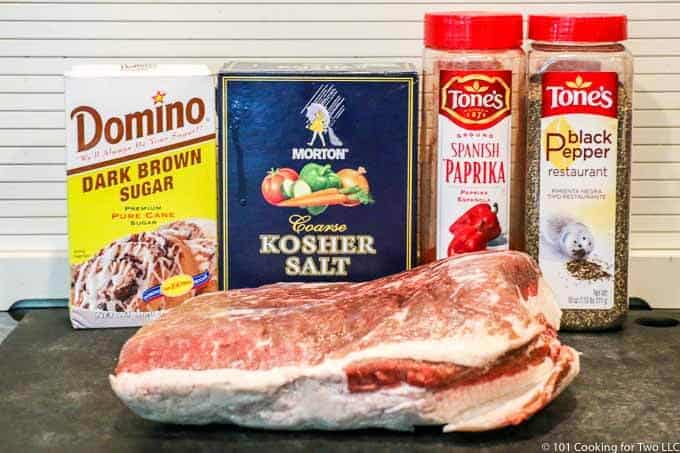
I started with a 5-pound point half of brisket this time.
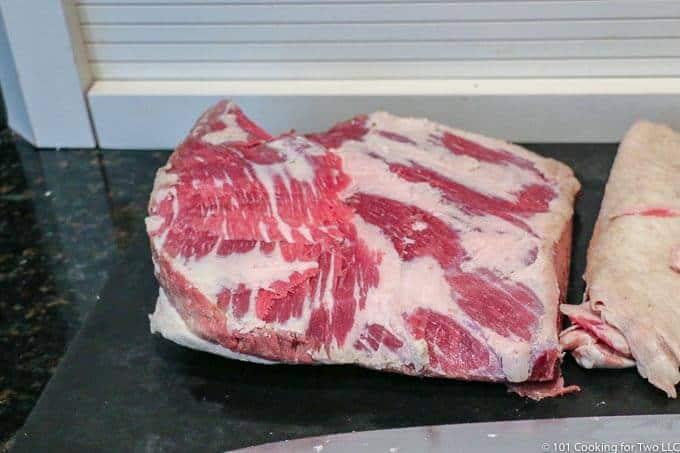
Trim brisket of any large chunks of fat and the fat cap. Don't try to be perfect. Some people don't trim or will leave a ¼ inch thick layer. Personal choice.
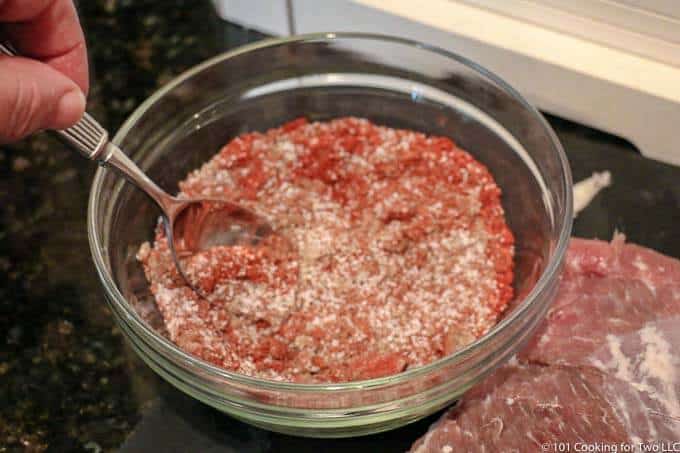
Use the rub of your choice or you may use mine. For my rub, mix rub of ¼ cup each brown sugar and paprika. Add two tablespoons each of kosher salt and black pepper and mix well.
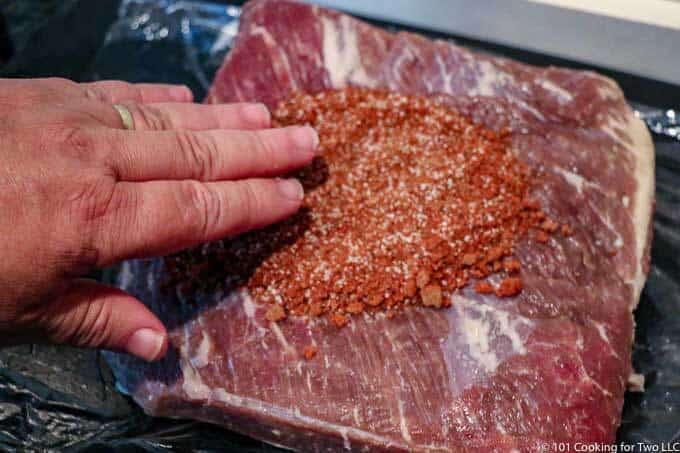
Give all sides of the brisket a heavy rub of the spices. Wrap with plastic wrap and refrigerate for a few hours or overnight. Remove from refrigeration about 1 hour before cooking and allow to rest at room temperature.
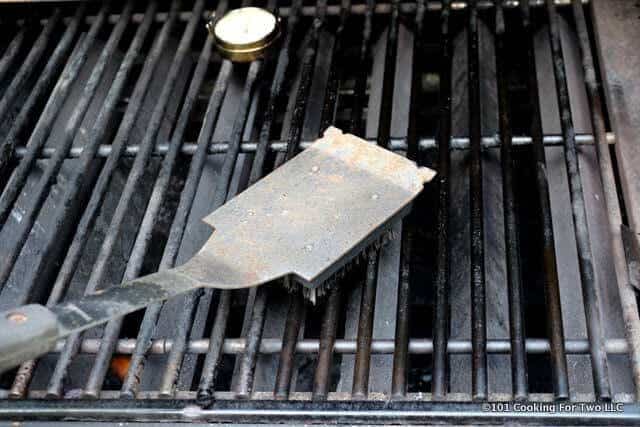
While the brisket is resting, set up the grill. You want a steady temperature of about 225°-250° with indirect heat with a drip pan on the indirect side and a way to create smoke. See How to Set Up a Gas Grill for Smoking.
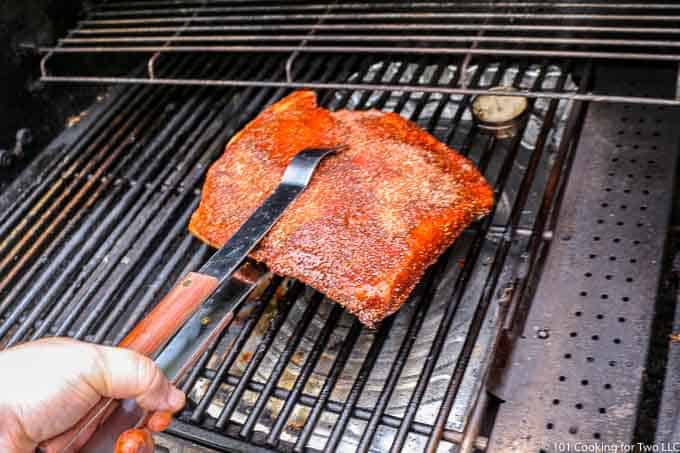
Cook on the indirect side over a drip pan.
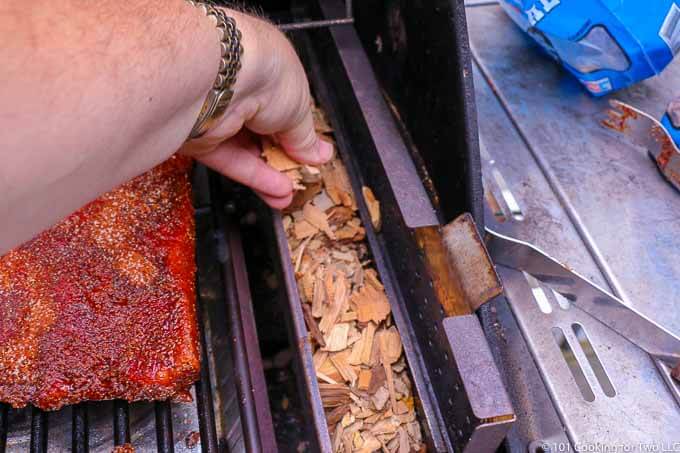
You need a method of adding some smoke to your brisket. The method, amount, and duration is up to you. I do about 1 hour of hickory with my built-in smoke box. Other methods are reviewed at How To Set Up Your Gas Grill for Smoking and Low and Slow Cooking.
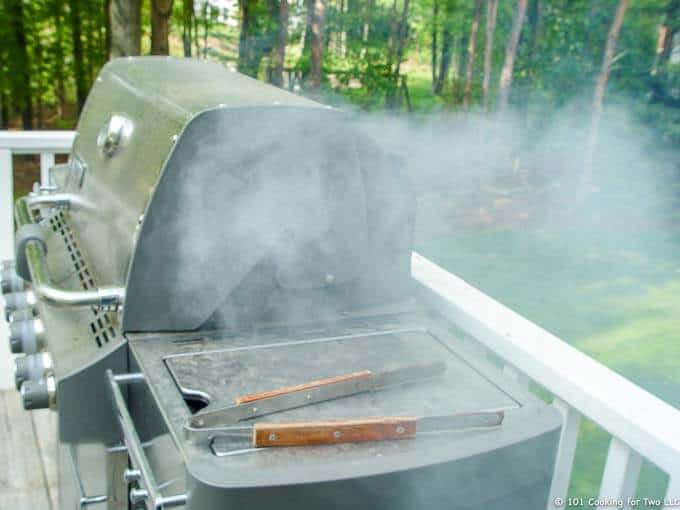
Cook until internal temp of 200°-205°. About 5 hours total cooking time for me with the 5 pound point.
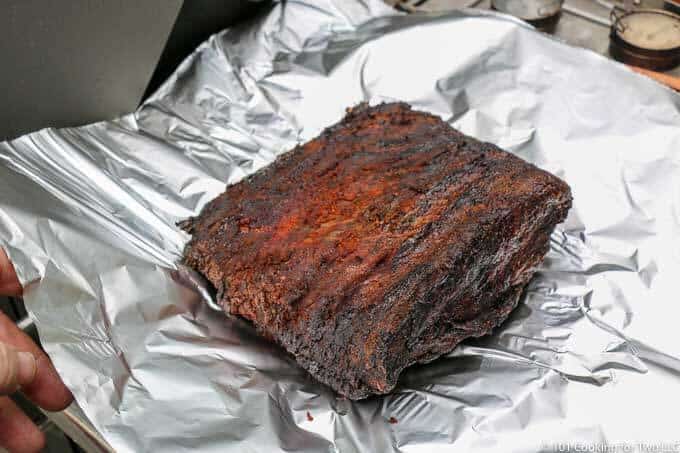
Remove from grill and wrap in foil and couple of towels.
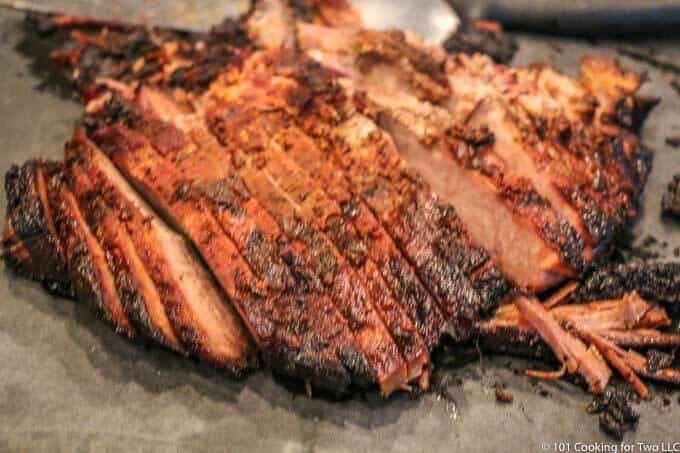
Allow to rest for 1-2 hours before cutting thin across the grain to serve.
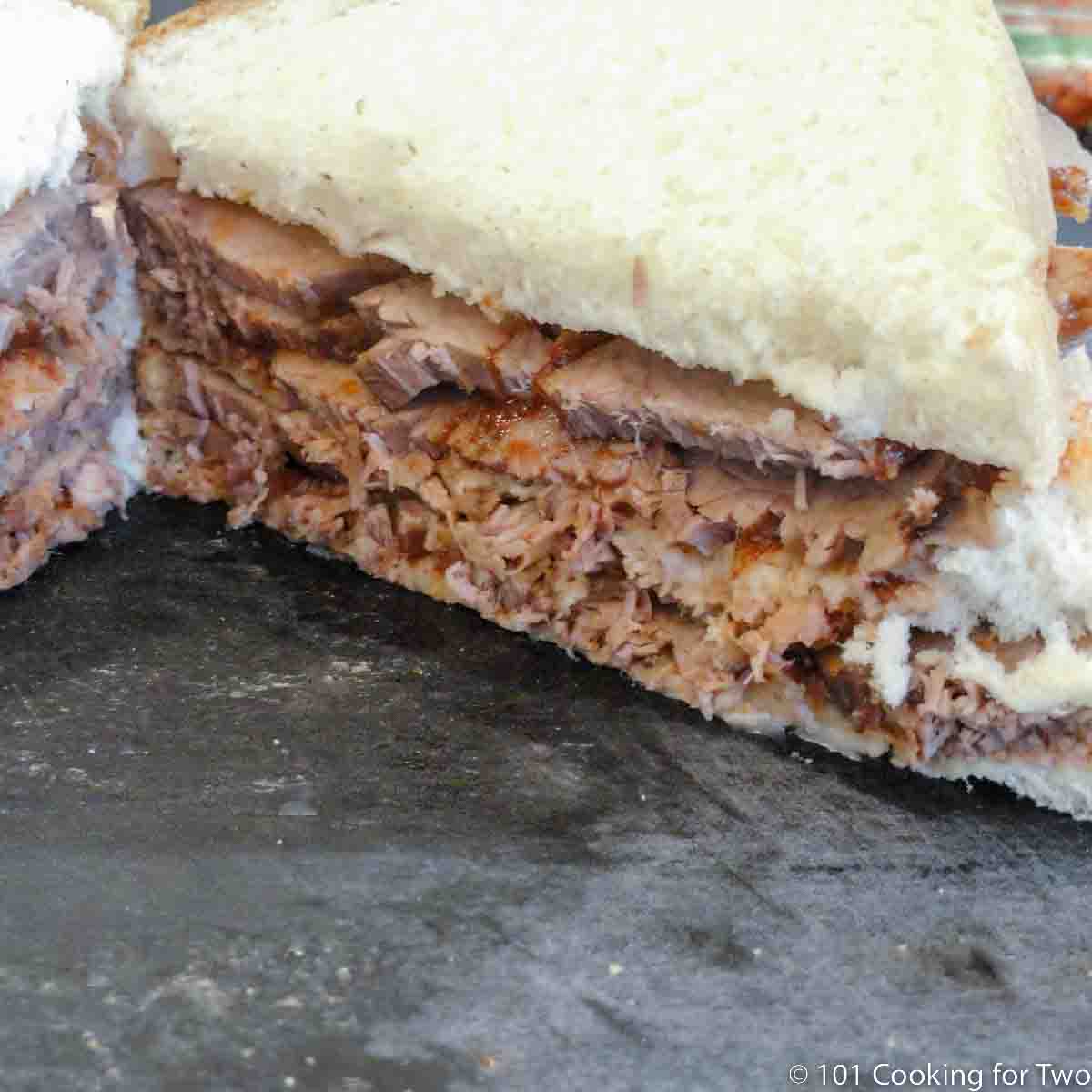

📖Recipe
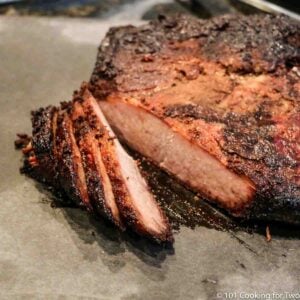
How to Cook a Brisket on a Gas Grill
Learn how easy it is to cook a brisket on your backyard gas grill with these easy to follow step by step photo instructions. You too can enjoy one of the Kings of BBQ at home.
Tap to leave a Rating
Servings #/Adjust if desired 10
- 5 pound Brisket - Size of your choice
My rub for a 5-pound brisket. Scale for different size. You may use the rub of your choice.
- ¼ cup brown sugar
- ¼ cup paprika
- 2 tablespoons kosher salt
- 2 tablespoons black pepper
-
I started with a 5 pound point half of a brisket this time.
-
Trim brisket of any large chunks of fat and the fat cap. Don't try to be perfect. Some people don't trim or will leave a ¼ inch thick layer. Personal choice.
-
Use the rub of your choice or you may use mine. For my rub, mix rub of ¼ cup each brown sugar and paprika. Add two tablespoons each of kosher salt and black pepper and mix well.
-
Give all sides of the brisket a heavy rub of the spices. Wrap with plastic wrap and refrigerate for a few hours or overnight. Remove from refrigeration about 1 hour before cooking and allow to rest at room temperature.
-
While the brisket is resting, set up the grill. You want a steady temperature of about 225°-250° with indirect heat with a drip pan on the indirect side and a way to create smoke. See How to Set Up a Gas Grill for Smoking.
-
Cook on the indirect side over a drip pan.
-
You need a method of adding some smoke to your brisket. The method, amount, and duration is up to you. I do about 1 hour of hickory with my built in smoke box. Other methods are reviewed at How To Set Up Your Gas Grill for Smoking and Low and Slow Cooking.
-
Cook until internal temp of 200°-205°. About 5 hours total cooking time for me with the 5 pound point.
-
Remove from grill and wrap in foil and couple of towels.
-
Allow to rest for 1-2 hours before cutting thin across the grain to serve.
See the step-by-step photos in the post. Some recipes have an option to display the photos here with a switch above these instructions but the photos DO NOT print.
![]()
Prevent your screen from going dark
Pro Tips
- The set up of the grill for low and slow cooking plus smoking is the most important part of cooking a brisket on a gas grill.
- Use the rub of your choice, but I include a suggested rub.
- I usually will do smoke for about an hour, but more is fine.
- Cooking time varies a lot but 1-1 ½ hour per pound is a good starting point to estimate your cooking time.
- Be sure to wrap and let sit after cooking for 1-2 hours.
- You must cut across the grain.
- See the writeup about injection, brine, the stall, and Texas crutch.
- For serving size, I suggest 6-8 oz. unless you are talking a teenage boy, then double. You also want leftovers.
- This recipe scales up well but a large whole brisket may take 12-16 hours, and you want to read my discussion about the Texas crutch in the main post above.
- Good in refrigerator for 3-4 days and freezer for 3-4 months.
- Please see How to Set Up a Gas Grill for Smoking and A Beginners Guide to Grill Temperature on a Gas Grill for low and slow grill set up instructions if you need help.
To adjust the recipe size:
You may adjust the number of servings in this recipe card under servings. This does the math for the ingredients for you. BUT it does NOT adjust the text of the instructions. So you need to do that yourself.
Serving : 8 oz. | Calories : 595 kcal (30%) | Carbohydrates : 7 g (2%) | Protein : 42 g (84%) | Fat : 43 g (66%) | Saturated Fat : 17 g (85%) | Polyunsaturated Fat : 2 g | Monounsaturated Fat : 19 g | Cholesterol : 154 mg (51%) | Sodium : 1342 mg (56%) | Potassium : 676 mg (19%) | Fiber : 0.4 g (2%) | Sugar : 6 g (7%) | Vitamin A : 50 IU (1%) | Vitamin C : 0.8 mg (1%) | Calcium : 30 mg (3%) | Iron : 4.3 mg (24%)
Serving size is my estimate of a normal size unless stated otherwise. The number of servings per recipe is stated above. This is home cooking, and there are many variables. All nutritional information are estimates and may vary from your actual results. To taste ingredients such as salt will be my estimate of the average used.
© 101 Cooking for Two, LLC. All content and photographs are copyright protected by us or our vendors. While we appreciate your sharing our recipes, please realize copying, pasting, or duplicating full recipes to any social media, website, or electronic/printed media is strictly prohibited and a violation of our copyrights.
Editor's Note: Originally Published July 28, 2014. Updated with expanded options, refreshed photos, and a table of contents to help navigation.

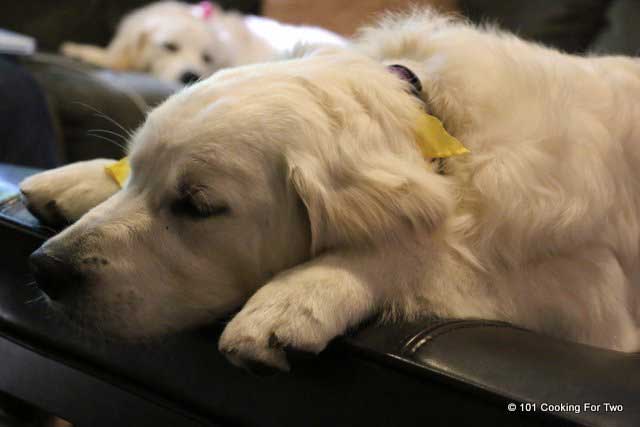
Today's dog picture features two very tired puppies. We were out of town for a week, and the dogs went to the dog spa. Yep, and it really is doggie vacation time. It took them two days to recover. Countryside Kennels Pet Resort & Spa. If you look around the site, you will see our girls in a few pictures.
Source: https://www.101cookingfortwo.com/cook-brisket-gas-grill/
0 Response to "Smoking a Beef Brisket on a Gas Grill"
Publicar un comentario